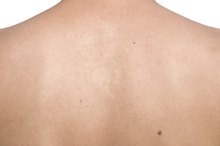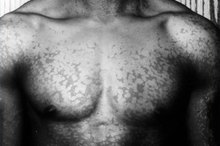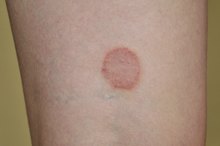What does fact checked mean?
At Healthfully, we strive to deliver objective content that is accurate and up-to-date. Our team periodically reviews articles in order to ensure content quality. The sources cited below consist of evidence from peer-reviewed journals, prominent medical organizations, academic associations, and government data.
The information contained on this site is for informational purposes only, and should not be used as a substitute for the advice of a professional health care provider. Please check with the appropriate physician regarding health questions and concerns. Although we strive to deliver accurate and up-to-date information, no guarantee to that effect is made.
How Long Does It Take for Ringworm to Clear Up?
Ringworm, or tinea, is a highly contagious fungal infection that often presents in the shape of a small ring on the surface of the skin. This is a condition that does not go away on its own and must be treated with some form of antifungal medication. Over-the-counter medications can first be tried, but in severe cases requiring a prescription, ringworm takes several weeks and sometimes up to three months to clear completely.
If you are experiencing serious medical symptoms, seek emergency treatment immediately.
Causes
Ringworm is caused by skin-to-skin contact with people or animals who already have the fungal infection present on their skin. This means that ringworm infections commonly occur at schools where children have a great deal of contact with one another and among athletes such as wrestlers. Not all people who have the ringworm fungus show symptoms, so a person may pass the infection on to others without knowing, making infections difficult to trace from person to person.
Types
Does Ringworm Go Away on Its Own?
Learn More
There are many different types of ringworm, and not all present as the ring-shaped rash most commonly associated with the fungus. The type of ringworm that often appears on the scalps of children is hard and scaly and leads to bald spots. Another type of ringworm appears on the face and neck in areas covered by facial hair and presents with swelling and crusting of the skin. The form of ringworm that is commonly known as jock itch appears in the folds of the groin and on the thighs as a reddish-brown rash. Finally, there is the type of ringworm that does show up as ring-shaped rashes and can occur anywhere on the body.
- There are many different types of ringworm, and not all present as the ring-shaped rash most commonly associated with the fungus.
- The type of ringworm that often appears on the scalps of children is hard and scaly and leads to bald spots.
Identification
It can be easy to identify ringworm when in the well-known ring shape, but even then it is important to seek diagnosis from a doctor to rule out other skin conditions. Eczema, psoriasis and even yeast infections can look quite similar to the different forms of ringworm, so a proper diagnosis is key to finding the right course of treatment. A physician may be able to identify ringworm by sight, or may take a skin scraping for further testing.
Prevention
Ringworm in Babies
Learn More
There is no absolute way to prevent contracting ringworm because of the skin-to-skin nature of its transmission. However, frequent and proper hand washing cuts down on all skin infections. Avoiding contact with people and animals known to have ringworm and situations that leave the skin sweaty and moist can also cut down on breakouts of the fungus. For men this may mean wearing boxers rather than briefs and for women, wearing cotton undergarments and avoiding nylons altogether.
- There is no absolute way to prevent contracting ringworm because of the skin-to-skin nature of its transmission.
- Avoiding contact with people and animals known to have ringworm and situations that leave the skin sweaty and moist can also cut down on breakouts of the fungus.
Topical Treatment
Mild cases of ringworm can be treated with over-the-counter topical medications such as Lamisil and Tinactin. These medications are used for many mild fungal infections. Follow the instructions that come with the cream for treatment and if the ringworm does not clear up within two weeks, seek a prescription ointment from your doctor. Prescription creams are much stronger and are generally used in a thin layer once or twice a day. Apply these creams as prescribed, as they may need to be continued even after the visual signs have cleared to make sure there is no reoccurrence. Ringworm severe enough to require a prescription cream may take several weeks to clear.
- Mild cases of ringworm can be treated with over-the-counter topical medications such as Lamisil and Tinactin.
- Apply these creams as prescribed, as they may need to be continued even after the visual signs have cleared to make sure there is no reoccurrence.
Oral Treatment
If a case of ringworm is too severe to be treated with a mere over-the-counter topical ointment and does not respond to a prescription cream, an oral antifungal medication will be prescribed. An oral medication will generally be prescribed for four to eight weeks and may be continued if the skin shows improvement but does not completely clear. There is often a tendency to cease taking a medication when the ringworm starts to clear up, however, just because the visible signs are gone does not mean the fungus itself is gone and the rings and rashes can reappear if the full course of treatment is not followed.
Related Articles
References
- Cornell University College of Veterinary Medicine. Ringworm: A Serious but Readily Treatable Affliction. 2018.
- Centers for Disease Control and Prevention. Ringworm Information for Healthcare Professionals. Updated February 6, 2020.
- Ely JW, Rosenfeld S, Seabury Stone M. Diagnosis and management of tinea infections. Am Fam Physician. 2014;90(10):702-710.
- American Academy of Dermatology. “Ringworm: Diagnosis, Treatment, and Outcome.”
- Laniosz V, Wetter DA. "What's New in the Treatment and Diagnosis of Dermatophytosis?" Seminars in Cutaneous Medicine and Surgery. 2014 Sep;33(3):136-9.









